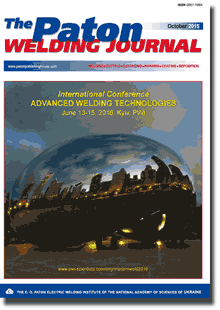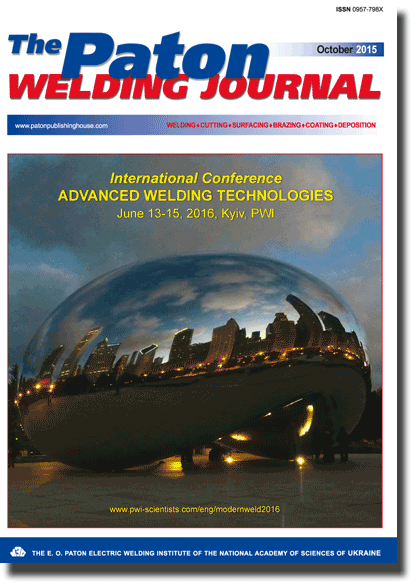Access for download PDF files for subscribers and for reviewers of scientometric bases.
Organization: Elsevier for content access(PDF files of journals released before 2024 are available for download from the website's archives))
Organization: Elsevier for content access(PDF files of journals released before 2024 are available for download from the website's archives))
| 2015 №10 (07) |
DOI of Article 10.15407/tpwj2015.10.08 |
2015 №10 (09) |

The Paton Welding Journal, 2015, #10, 47-51 pages
Method of evaluation of thermal resistance of multilayer deposited metal
A.A. Babinets
E.O. Paton Electric Welding Institute, NASU 11 Bozhenko Str., 03680, Kiev, Ukraine. E-mail: office@paton.kiev.ua
Abstract
At the present time there is no generally-accepted procedure of testing the thermal resistance of multilayer deposited specimens. The existing sufficiently widely used method of evaluation of thermal resistance, based on determination of number of heating-cooling cycles up to the appearance of a network of thermal cracks, does not allow carrying out a precise evaluation of thermal resistance during testing of multilayer deposited specimens possessing a rather high thermal resistance. The aim of the work consists in development or improvement of the procedure of evaluation of thermal resistance of the multilayer deposited metal, which could allow investigating the dynamics of propagation of thermal cracks in depth of the deposited layer and its change depending on characteristics of the deposited layers. The procedure, developed at the E.O. Paton Electric Welding Institute, was improved that made it possible to carry out the precise evaluation of thermal resistance of the deposited metal. It was found that the fusion line nature has a definite effect on thermal resistance of the specimen as a whole. In this case the surfacing of a ductile sublayer by wire Sv-08A contributes to arresting the growth of the thermal fatigue cracks and increase in total thermal resistance approximately by 20 %. The improved procedure can be used for the precise evaluation of thermal resistance of surfacing materials, used in manufacture or restoration surfacing of tools for hot deforming. 12 Ref., 1 Table, 7 Figures.
Keywords: arc surfacing, multilayer deposited metal, procedure of tests
Received: 09.07.15
Published: 01.12.15
References
- Dulnev, R.A., Kotov, P.I. (1980) Thermal fatigue of metals. Moscow: Mashinostroenie.
- Tylkin, M.A. (1971) Increase in service life of metallurgical equipment parts. Moscow: Metallurgiya.
- Frumin, I.I. (1961) Automatic electric arc surfacing. Kharkov: Metallurgizdat.
- Ryabtsev, I.A., Kondratiev, I.A. (1999) Mechanized electric arc surfacing of metallurgical equipment parts: Refer. Book. Kiev: Ekotekhnologiya.
- Tolstov, I.A., Pryakhin, A.V., Nikolaev, V.A. (1990) Increase in serviceability of hot working tool. Moscow: Metallurgiya.
- GOST 25.505-85: Methods of mechanical testing of metals. Method of test on low-cycle fatigue in thermomechanical loading.
- Shkolnik, L.M. (1978) Procedure of fatigue tests: Refer. Book. Moscow: Metallurgiya.
- Marek, A., Junak, G., Okrajni, J. (2009) Fatigue life of creep resisting steels under conditions of cyclic mechanical and thermal interactions. Archives of Materials Sci. and Eng., Vol. 40, Issue 1, 37-40.
- Lanin, A.G. (1998) Methods of determination of thermal resistance (Review). Zavod. Laboratoriya. Diagnostika Materialov, 3, 31-47.
- Ryabtsev, I.I., Chernyak, Ya.P., Osin, V.V. (2004) Block-module unit for tests of deposited metal. Svarshchik, 1, 18-20.
- Ryabtsev, I.A., Babinets, A.A., Ryabtsev, I.I. (2011) Effect of ductile sub-layer on heat resistance of multilayer deposited metal. The Paton Welding J., 10, 18-21.
- Babinets, A.A., Ryabtsev, I.A., Kondratiev, I.A. et al. (2014) Investigation of thermal resistance of deposited metal designed for restoration of mill rolls. Ibid., 5, 16-20. https://doi.org/10.15407/tpwj2014.05.03
Suggested Citation
A.A. Babinets (2015) Method of evaluation of thermal resistance of multilayer deposited metal. The Paton Welding J., 10, 47-51.The cost of subscription/purchase order journals or individual articles
| Journal/Currency | Annual Set | 1 issue printed |
1 issue |
one article |
| TPWJ/USD | 384 $ | 32 $ | 26 $ | 13 $ |
| TPWJ/EUR | 348 € | 29 € | 24 € | 12 € |
| TPWJ/UAH | 7200 UAH | 600 UAH | 600 UAH | 280 UAH |
| AS/UAH | 1800 UAH | 300 UAH | 300 UAH | 150 UAH |
| AS/USD | 192 $ | 32 $ | 26 $ | 13 $ |
| AS/EUR | 180 € | 30 € | 25 € | 12 € |
| SEM/UAH | 1200 UAH | 300 UAH | 300 UAH | 150 UAH |
| SEM/USD | 128 $ | 32 $ | 26 $ | 13 $ |
| SEM/EUR | 120 € | 30 € | 25 € | 12 € |
| TDNK/UAH | 1200 UAH | 300 UAH | 300 UAH | 150 UAH |
| TDNK/USD | 128 $ | 32 $ | 26 $ | 13 $ |
| TDNK/EUR | 120 € | 30 € | 25 € | 15 € |
AS = «Automatic Welding» - 6 issues per year;
TPWJ = «PATON WELDING JOURNAL» - 12 issues per year;
SEM = «Electrometallurgy Today» - 4 issues per year;
TDNK = «Technical Diagnostics and Non-Destructive Testing» - 4 issues per year.


